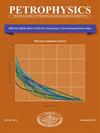Probe Screening Techniques for Rapid, High-Resolution Core Analysis and Their Potential Usefulness for Energy Transition Applications
IF 0.7
4区 工程技术
Q3 ENGINEERING, PETROLEUM
引用次数: 0
Abstract
Core analysis techniques have traditionally been used mainly for hydrocarbon reservoir applications. However, the same techniques are equally applicable to reservoir issues associated with energy transition, such as geothermal prospects, carbon geosequestration, and hydrogen storage. Traditionally, much core analysis has been performed successfully using core plugs. However, this approach has certain drawbacks: (1) the selected plugs may not necessarily be representative of the full range of lithologies, (2) key features (e.g., thin naturally cemented or fractured zones) may be missed, (3) high-resolution detail at the lamina scale may be missed, (4) depth shifting to well logs may not be sufficiently accurate, and (5) this strategy may be more sensitive to missing core. In this paper, we highlight the usefulness of probe core analysis techniques on slabbed core and powdered samples. For many reservoirs relevant to energy transition, it is crucial to have a high-resolution continuous record of petrophysical properties so that key features are not missed. Probe measurements are less destructive, without the need to cut core plugs, and provide: (1) high-resolution data at the lamina scale so that key features and small-scale heterogeneities can be identified, (2) improved depth matching to well-log data, and (3) rapid, cost-effective data. We describe examples highlighting some different probe techniques. While some techniques are well known, such as probe permeability, others, such as probe acoustics, probe luminance (from linear X-ray measurements), and probe magnetics, are less familiar to core analysts but are well suited for analyzing cores from reservoirs associated with energy transition as well as hydrocarbons. For example, potential geothermal prospects involve studying igneous and metamorphic samples (where the main radiogenic heat sources reside) as well as sedimentary samples, and differences in the magnetic susceptibility signals using a small, portable magnetic probe can quickly differentiate the different rock types. Probe acoustics can be used to (1) rapidly identify anisotropy by orienting the acoustic transmitter-receiver bracket in different directions, (2) identify open microfractures via longer transit times, and (3) produce high-resolution porosity profiles after correlation of transit times with some representative plug or well-log porosity data. Probe luminance and associated linear X-ray images, which are related to density, can indicate small-scale heterogeneities that may impact permeability variation and anisotropy and may not be seen from mere visual observations of the slabbed core surface.用于快速、高分辨率岩心分析的探针筛选技术及其在能量转换应用中的潜在用途
岩心分析技术传统上主要用于油气储层。然而,同样的技术同样适用于与能源转换相关的储层问题,如地热勘探、碳地质封存和氢储存。传统上,许多岩心分析都是使用岩心塞成功完成的。然而,这种方法也有一定的缺点:(1)选择的桥塞不一定能代表所有岩性;(2)可能会遗漏关键特征(例如,薄的天然胶结或裂缝带);(3)可能会遗漏层状尺度上的高分辨率细节;(4)深度转换到测井曲线可能不够准确;(5)该策略可能对缺失的岩心更敏感。在本文中,我们强调了探针岩芯分析技术对片状岩芯和粉末样品的有用性。对于许多与能源转换相关的储层来说,拥有高分辨率的岩石物性连续记录是至关重要的,这样就不会遗漏关键特征。探头测量的破坏性较小,不需要切割岩心桥塞,并提供:(1)在层状尺度上的高分辨率数据,以便识别关键特征和小尺度非均质性;(2)改善了与测井数据的深度匹配;(3)快速、经济有效的数据。我们描述了一些例子,重点介绍了一些不同的探测技术。虽然有些技术是众所周知的,如探头渗透率,但其他技术,如探头声学、探头亮度(来自线性x射线测量)和探头磁性,对岩心分析人员来说不太熟悉,但非常适合分析与能量转换和碳氢化合物相关的储层岩心。例如,潜在的地热前景包括研究火成岩和变质岩样品(主要的放射性成因热源所在)以及沉积样品,使用小型便携式磁探头在磁化率信号上的差异可以快速区分不同的岩石类型。探头声学可用于(1)通过将声波发射器-接收器支架定向到不同方向来快速识别各向异性;(2)通过更长的传递时间来识别开放的微裂缝;(3)通过将传递时间与一些具有代表性的桥塞或测井孔隙度数据进行对比,得到高分辨率的孔隙度剖面。探针亮度和相关的线性x射线图像与密度相关,可以指示可能影响渗透率变化和各向异性的小尺度非均质性,这些非均质性可能无法从片状岩心表面的视觉观察中看到。
本文章由计算机程序翻译,如有差异,请以英文原文为准。
求助全文
约1分钟内获得全文
求助全文
来源期刊

Petrophysics
地学-地球化学与地球物理
CiteScore
1.80
自引率
11.10%
发文量
40
审稿时长
>12 weeks
期刊介绍:
Petrophysics contains original contributions on theoretical and applied aspects of formation evaluation, including both open hole and cased hole well logging, core analysis and formation testing.
 求助内容:
求助内容: 应助结果提醒方式:
应助结果提醒方式:


